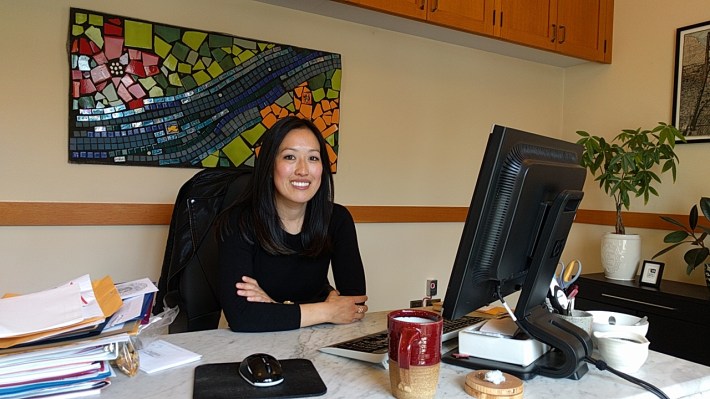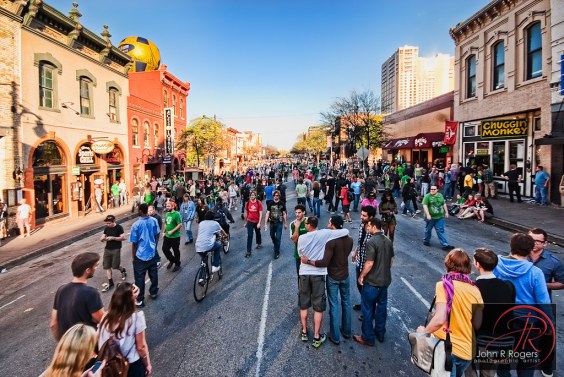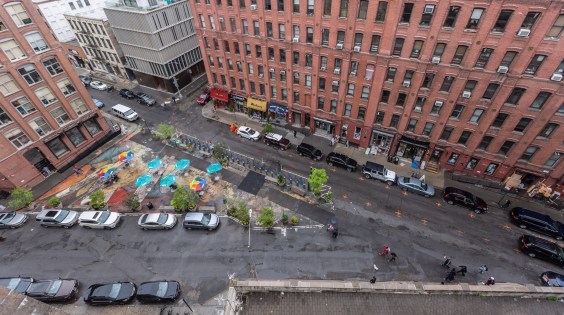
Last week, Streetsblog brought you an editorial from Katy Tang about the issue of installing concrete boarding islands on Taraval as part of SFMTA's Muni Forward project. This was in response to a headline in the SF Examiner, that declared "Supervisor Slams Brakes on L-Taraval Changes."
As Streetsblog readers may recall, business owners were pushing back against the boarding islands because of the potential loss of parking in front of their shops; Streetsblog brought you the story of the rancorous public meeting about it, and other issues, back in February.
Is it true that Supervisor Tang was holding up safety improvements because of her small-business constituents and their objections? Streetsblog had reached out to Tang several times. Finally, Friday, Streetsblog was able to sit down with the District 4 Supervisor and get her perspective, face to face.
STREETSBLOG: The Examiner story was accurate, with the exception of the headline?
TANG: Factually, it was true. It just didn't tell people all of what was going on.
SB: So what is going on? Let's pick this up from that infamous meeting with the community at Dianne Feinstein Elementary about Muni's proposed improvements to the L-Taraval.
TANG: At that large meeting, everyone was yelling at each other and not giving time to hear people. We heard from people that they were confused about what SFMTA proposals were on Taraval. It's not just about boarding islands. It might be about transit-only lanes. Parking removals associated with boarding islands. Traffic signals. Stop removals. So it was a whole host of things. You had to look at every intersection to know what's going on. Because those meetings were just shouting fests, and it wasn't just that one, there were several, we felt like, you know what? We're not being productive. MTA wants feedback, and people aren't providing feedback, they're just yelling.
SB: So you arranged smaller meetings?

KT: Yes. Through the focus groups, we're trying to say maybe it's not such a good idea to put the boarding island right in front of, say, a hardware store or a pet hospital. Maybe there's a stop location that's more appropriate.
SB: So it's not about eliminating boarding islands. It's about, potentially, relocating some stops?
KT: MTA was already talking about consolidation. So can you put all of those factors together to make it the best spot possible while achieving everyone's goals. So that's what I'm waiting to see.
SB: It's so odd that some businesses don't want a stop--it's like saying: "Make all those potential customers on the train roll past my shop and get off somewhere else!"
KT: A merchant pointed out, which I can see about the Sunset, our district is so spread out, it's not like Ocean Avenue or Irving Street. On Taraval it's kind of like, here's a tranche, here's a tranche--it's a little disjointed. So people tend to do things by car and they'll stop here at the post office, and stop here at the cafe, and stop here to do dry cleaning. Because people drive so much, that's why there's parking. I'm just reflecting what they're saying.
SB: I'm wondering as a supervisor, though, how do you deal with what they're saying on those occasions when what they're saying makes no sense. For example, when we did a story on the Mission Street red-carpet [transit only] lanes, we met with business owners that said, for example, the treatment had eliminated their loading zones, when in fact there were three loading zones right outside the shop. It's as if they live in an alternate reality.
KT: Taraval's a little different from Mission. I don't know that Taraval necessarily warrants the red carpets to be honest. In my experience growing up always around the L line, I've never seen the cars being the issue for the L--cars blocking the train.
SB: What is the issue that makes the L so slow? Too many stops?
KT: Stops everywhere. They revised it down a little.
SB: Consolidating stops seems like a no-brainer.
KT: But the seniors have been very vocal about not walking another block or two in order to catch the train. Now I don't know what MTA is planning on doing ultimately.
SB: What about signal pre-emption?
KT: That's what they're working on.
SB: Is anyone opposed to it?
KT: Yes. (laughs)
SB: Why?
KT: It's Taraval Street. When there's no train, people are worried they'll end up stopped for no good reason.
SB: Why would that happen?
KT: If there's no train, you could be stopped at a light for a while. It's slower than stopping at a stop sign.
SB: No, no, the idea is the train would trigger the light to turn red for the cars as the train approaches.
KT: Only if the train is there, but if you're just a car, and no train is nearby, then you're going to be stopped at a stop light much longer than you would at a stop sign.
SB: Oh, for the cycle of the light. Yes, I suppose. But we're supposed to be doing what we can to prioritize the train.
KT: Just relaying people's concerns. It's an artery for cars. So they worry that it will drive traffic to the side streets, such as Ulloa Street, Vicente, Santiago--that's what I've heard.
SB: Getting back to the big meeting at Di-Fi Elementary, someone from MTA mentioned that 22 people had been hit getting off trains, so someone in the audience reacted with "that doesn't seem like a lot." That struck me as such an inhumane perspective.
KT: We were pretty appalled by some of the comments. I think in those large group settings people feel emboldened to say things like that. In the smaller settings it was much more civilized. There was more of a sense that it's unacceptable to be saying something like that. Unfortunately, I have to listen to everyone regardless of their opinion. I can't just tune people out. My goal was to direct it in a more positive matter.
SB: What is your opinion on that?
KT: On what?
SB: On the idea that we should cancel the boarding islands because 22 people isn't that much.
KT: I agree with MTA's position. They have data that people are getting hit. Boarding islands are non-negotiable.
SB: So why do some small businesses freak out about this stuff?
KT: I have experience working with merchants from my job on Taraval and Irving. They are on pins and needles because the rules are constantly changing. They see it all as "government," whether it's state law, or city law, it's all bundled into one thing: healthcare, minimum wage, they're just on pins and needles because one thing could just throw their business off. So I don't blame them for being fearful of changes such as parking impacts. At the same time, when these changes happen, yes, we monitor and see if the negative impacts are really true. So let's look to examples where it has happened already, such as Ocean [which has boarding islands already] where it hasn't impacted business, or maybe it made it better, but I do think it's important to look at places where it has worked. I think in this case the Taraval changes got paired with the Mission Street changes, so people are saying, oh look, MTA is back tracking now. And they're equating it to let what's happened on Mission Street.
SB: They think SFMTA's going to do the same thing they did on Mission? They do realize you can't move the tracks on Taraval over to the right lanes and paint them red? I had to get that in there.
KT: (laughs) Taraval is a business corridor that we want to revitalize, so me supporting safety and boarding islands doesn't mean that I want to destroy our businesses.
SB: Last question, you didn't do very well in the Muni challenge. In fact, you came in last.
KT: Oh!
SB: Why?
KT: I'm 32 now. I started riding when I was in the sixth grade--I've ridden it way more than 22 days. I don't need to be Tweeting or Facebooking about it to show people that I'm riding it.
This interview was edited for length and clarity.




